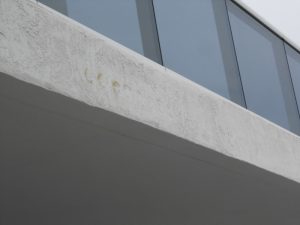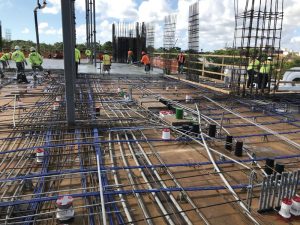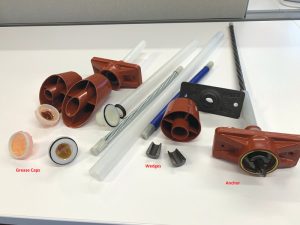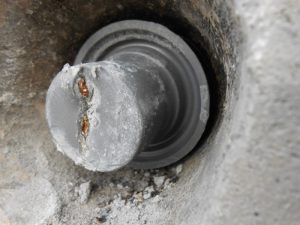The South Florida Grease Cap Debate
High-rise residential concrete construction in South Florida typically consists of unbonded post-tensioned concrete slab construction. A key component to the durability of these slabs is the finishing of the stressing pockets for the post-tensioned tendons, which has proven to be problematic for contractors, especially in South Florida. Tendon finishing consists of cutting/greasing cable ends and capping and filling the pockets with grout.
This article presents both sides of an ongoing debate that is the focus of many lawsuits in condominiums throughout South Florida. The dispute involves improper finishing of post-tensioned tendons and whether or not the tendon encapsulation requires a repair.
Plaintiffs (i.e., building owners) argue for compliant construction. Thus, the owners argue that every post-tension stressing pocket on a building must be opened, cables properly trimmed, and new grease caps installed. Frequently, there are thousands of stressing pockets on a high-rise condominium resulting in lawsuits in the millions of dollars.
Defendants (i.e., design professionals, inspectors, contractors, subcontractors, etc.) argue that if it is not broken then do not fix it. The tendons are meeting their intended function of supporting the building loads and not showing signs of distress, so opening thousands of pockets is unnecessary and wasteful.
The author discusses the current codes and proposes engineering solutions for resolving these disputes.
Background
Currently, in South Florida, many high-rise residential buildings are undergoing costly repairs to correct defectively installed post-tensioned systems. Many of these buildings are 5-10 years old and show no signs of distress. Are these repairs necessary, or are they economic waste? This is the question that is currently being debated among engineers and attorneys, resulting in costly lawsuits. To answer the question, an understanding of how post-tensioned systems work is important.
Post-tensioned systems consist of a series of cables embedded within concrete slabs that, once stressed, support the loads imposed on the slabs (Figure 1). An unbonded system uses tendons placed within sheathing so that, after the concrete hardens, the tendons can move along the sheathing within the slab without bonding to the concrete. Once the concrete hardens and reaches a specified strength, the tendons are stressed and locked into place using wedges (Figure 2).
The tendons elongate during stressing, the excess length is trimmed off, and the tendon ends are greased and capped. This is where the problems occur. Often, the tendons are not trimmed short enough for the caps to fit properly. Contractors either do not install the caps covering the anchor tightly or force them into place, resulting in the cable ends puncturing the caps (Figure 3). In either case, the construction is defective and does not meet the encapsulation watertight requirements of ACI 318-14 and ACI 423.7-14. Watertight encapsulation of the post-tension tendon intends to protect the tendon from corrosion failure so that the tendon functions for the useful life of the structure.
Plaintiff Approach
Experts engaged on behalf of condominium associations are tasked with identifying construction and design deficiencies as these properties change hands from developer to association-controlled. In South Florida, it has become standard operating procedure to open post-tension pockets during these investigations, whether the building shows symptoms of distress or not. During these investigations, the encapsulation of the post-tension tendons is frequently found deficient, with poorly installed or missing grease caps. After the grout, grease, and caps are removed, the tendon tails and anchorages are evaluated. The tendons and their anchorages are found to be undamaged and functioning as intended, despite the improper grease cap installation. Some plaintiff experts make the argument that the tendons will not last for their intended useful life and argue that all pockets on the building must be opened and repaired. The repairs that the plaintiff experts recommend typically consist of non-structural repairs of trimming cable ends, regreasing the cables/anchorages, recapping the tendons, and regrouting the pockets. This is a very conservative approach to the issue and does not consider the significant useful life remaining in the post-tensioned system, even with improperly installed grease caps. The repairs are very disruptive to the residents and often take a year or more to complete.
Defense Approach
Defendants in these cases are quick to point out that construction is imperfect and that there are no damages that the Plaintiffs can identify. The experts argue that the post-tension system will last the intended useful life without repair. Some experts take samples of the grout and send them for laboratory testing, which can then be used to calculate the remaining useful life of the post-tensioning system. Other experts evaluate the tendons/anchorages after the grout/grease/caps have been removed, finding no corrosion within the pockets. The defense points out that the Plaintiff’s repair approach is non-structural and ignores the significant useful life remaining in the system. Thus, the Plaintiff’s repair is unnecessary and wasteful. Frequently, the defense expert opinion is that no repairs are necessary.
Compromise?
The author proposes the following approach, which has currently been accepted by the applicable building departments and implemented in at least two condominium projects in South Florida.

Figure 4. Ghosting and corrosion of post-tension (PT) pockets, which is an indicator of an underlying issue with the post-tension tendons.
- Visually evaluate the exterior of the building to identify signs of distress in the post-tensioning system, including cracks in the stucco, grease staining, corrosion, and displaced or delaminated stucco (Figure 4).
- Remove the stucco and evaluate the grout if any of the items in step 1 are identified.
- Remove the grout if it is cracked, broken, or has grease and corrosion staining on it.
- Evaluate the encapsulation and condition of the tendon if the grout is removed.
- Recap, grease, and grout the pockets that are opened. Repair any damaged/broken tendons.
- Do not open any pockets that show no signs of distress.
- Recommend that the Association conduct maintenance in a timely fashion, specifically repairing any cracks in the stucco and surrounding concrete.
The repairs to the post-tensioning system can be drastically reduced and be substantially less costly and disruptive to the occupants using this methodology while reducing the risks associated with the improper grease cap installation.
Best Practices for New Construction
The best way to handle encapsulation issues is to avoid them altogether. With some simple improvements in design, construction, and technology, these costly litigations are hopefully becoming a thing of the past. Three recommendations are as follows:
- Design the slabs to be stressed inside the building via pour strips, elevator shafts, stairwells, etc. on the interior of the building where the building envelope protects the stressing ends. These are much less likely to be exposed to the environment. However, the vast majority of high-rise condominium post-tensioned floor slabs are stressed from the exterior slab edges. Many of these stressing pockets occur at highly vulnerable portions of the building, such as balconies or eyebrows, where regular exposure to the environment occurs. The disadvantage of stressing from the interior is that it is usually more time consuming and costly, at least initially.
- Plan for access to improve installation. There is better awareness in the industry of the importance of proper grease cap installation. Proper grease cap installation requires good access to the stressing pocket. In the past, contractors would remove their access to the pockets after stressing was complete before cutting, greasing, capping, and grouting the pockets. The contractors frequently would finish the pockets by standing/kneeling on the slab edge and reaching over to conduct work by feel. This practice led to many of the encapsulation problems that have been discussed in this article. Increased awareness of encapsulation issues has significantly reduced the finishing-by-feel technique. By leaving the access in place for a few days after stressing, contractors can vastly improve the finishing of the stressing pockets. Also, inspectors can get better access to the pockets to verify that the installations are proper.
- Take advantage of new tools. Improvements in post-tension technology have simplified the cutting/capping process of tendons. Tendon finishing has evolved from torch cutting of tendons to using shears and plasma cutting, which has resulted in improved accuracy/consistency of cutting to the proper length. Further, improvements in grease caps have made installation easier. Caps now have indicators for the installer to make sure they have been installed correctly. Examples include threaded caps screwed into place, tabs on the push style caps indicating when a cap is installed correctly, and deeper caps that can accommodate longer cables.
Improvements are occurring on new construction projects, and, with continued focus, costly litigations regarding this issue will become a thing of the past.
Conclusions
Expensive building-wide repairs are being contemplated and implemented in many recently constructed condominiums in South Florida. These repairs are often wasteful and unnecessary and can be significantly minimized by implementing engineering evaluations and regular building maintenance.■
References
International Code Council (ICC). (2017). Florida Building Code – Building (6th Edition.). Falls Church, VA: ICC.
American Concrete Institute (ACI). (2014). Building Code Requirements for Structural Concrete (ACI 318-14). Farmington Hills, MI: ACI.
American Concrete Institute (ACI). (2014). Specification for Unbonded Single-Strand Tendon Materials (ACI 423.7-14). Farmington Hills, MI: ACI.



